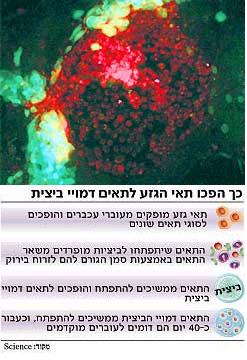Genetics / The experiment will affect the discussion of cloning and the border between male and female
5.5.2003
By: Tamara Traubman

In the picture above the table: the embryonic stem cells in the experiment; In green - the cells that will become egg-like. Photo: Courtesy of Karin Hibner and Hans Schuler
A study published at the end of the week raises, according to scientists, the possibility that a new way of creating life has been discovered. Scientists from the USA and France succeeded in turning embryonic stem cells, taken from male mice, into egg-like cells. According to experts, the discovery needs further confirmation, but it is already provoking a discussion among ethicists and theologians regarding questions such as - where is the biological border between male and female? According to the researchers, it is not surprising that eggs and embryo-like bodies were produced from female and male embryonic stem cells, because in the earliest stages of development the embryo's sex can be changed.
Embryonic stem cells are "identity-less" cells, found in day-old embryos. In the past, scientists have succeeded in turning this type of cells taken from human embryos into a variety of cells - such as brain, liver and blood cells, but the new research is the first time they have succeeded in turning stem cells into eggs. Moreover, according to the researchers, it appears that the eggs developed in the laboratory into embryos at the beginning of their journey through a process known as "in vitro fertilization", in which the egg begins to develop into an embryo without being fertilized by a sperm.
The heads of the research group, Dr. Karin Hibner and Dr. Hans Schuller from the University of Pennsylvania in Philadelphia, did not attempt to reproduce the experiment in human cells. However, in many cases it turned out that the biological structure of mouse cells and human cells is very similar.
The cells were taken from male and female mice. They multiplied in laboratory dishes into many types of cells, spontaneously, without the researchers directing their development. Hibner inserted a gene into the cells, which causes the germ cells - cells that will develop into eggs and seeds - to glow green. After a few days, she separated the green cells, and continued to monitor their development.
From the tests she performed, it emerged that about 40 days later some of the cells secreted proteins characteristic of eggs, and even underwent "meiosis" - a stage in the division of the unique cell into egg and sperm cells and essential for the beginning of life. "The trick was to find the marker, which would allow us to separate the early germ cells from the other cells," said Schuler in an interview accompanying the publication of the study in the scientific journal "Science
Today, scientists produce human embryonic stem cells from embryos created in vitro, but the couple decided that they did not want to use them to bring babies into the world. Because the production of the cells involves the destruction of the fetus, in the USA and some European countries there is strong opposition to the research of the cells and extensive restrictions are imposed on their use. These days the Senate is debating a bill that calls for a ban on cloning for research purposes.
The opposition stems in part from conservative and religious motives: according to the Christian concept, the fetus has the moral status of a human being already at the moment of fertilization and therefore should not be harmed. Jewish law does not see this as a problem, because according to its concept, the fetus receives the moral status of a human being only in the more advanced stages of pregnancy. In Israel, no public debate has developed on the matter, and the Ministry of Health does not impose restrictions on researchers beyond those that exist in normal genetic studies.
Scientists and ethicists predict that the new discovery will quell the opposition to stem cell research from religious and conservative reasons. "There is a deep challenge here to the Catholic perception, which is at the basis of most of the objections in the world," says Verdit Ravitzky, a doctoral student in ethics and genetics at Bar Ilan University. "The discovery will force us to reconsider what gives the moral status to a human being."
According to Ravitzki, the discovery introduces a new set of facts and considerations even into the controversy surrounding embryo cloning for the purpose of producing stem cells for research and healing. Scientists claim that cloning may make it possible to create embryos adapted to the genetic structure of each and every patient, and to produce special stem cells for him.
One of the objections to cloning embryos for the purpose of producing stem cells stems from the fact that providing the amount of eggs and embryos necessary to cure all patients would require a huge number of eggs. The demand will promote the perception of the egg as a "commodity", and may even lead to the creation of a "black market".
"The possibility of doing research on eggs, which were not taken from a woman's body, provides a successful response to this criticism," Ravitzki says. Currently, obtaining eggs involves an invasive and emotionally and physically difficult procedure, but if researchers succeed in creating eggs from human embryonic stem cells as well, they will have a new and abundant source of eggs for research.
According to Hermona Sorek, professor of biochemistry at the Hebrew University, "The findings are very interesting, the implications are very interesting - but the research should also be treated very carefully. The exact definition for the cells found is 'egg-like cells'. They answered the descriptive definition: they have a shape, proteins and connections with surrounding cells like an egg has, but can this cell also create a living being like an egg? It has not been proven yet."
